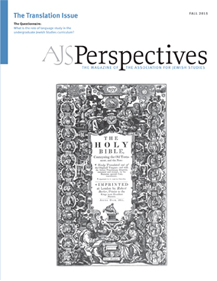Dear Colleagues,
Translation, in the technical sense of the term, originally referred to the removal of relics from one location to another. It describes a physical process by which material remains transition from holy space to holy space. Much of what is essential—dare we say holy—in Judaism is rooted in the textual, and thus is bound inextricably to language. But "translation" in Judaism is far from exclusively concerned with Scripture; Judaism and Jews' understanding of their Jewishness transformed time and again as the people migrated from place to place, from society to society, over the millennia.
One could argue that the very origins of Judaism lie in translation and language: in the transformation of the Israelites into the Jews during the Babylonian Exile, and the flourishing of an Egyptian Diaspora, as well. The Persian and Hellenistic periods witnessed tremendous cultural transformations of Judaism, and these transformations marked themselves in language: in the apparent need to translate the Torah, as recorded in Nehemiah 8 (perhaps the earliest mention of an Aramaic targum) and in the creation of the Greek Septuagint. The process of textual translation has been ongoing ever since, as communities navigated the imperative power of the Divine Word, yoked inextricably to the divine language (Hebrew) and the need and desire to understand those words in the vernacular. Translation affords the translator an opportunity to synthesize Holy Writ with his or her idea of holiness. Each translation—literal or metaphorical— makes a statement about alienation and ownership, estrangement and identity.
Of course, much of both Judaism and Jewish life beyond the text was translated over the centuries, and the metaphor of translation allows us to think about Judaism and Jewishness in all their rich and complicated manifestations over the last two thousand years and across the globe. Indeed, the ubiquity of translation as a motif throughout Jewish history means that everyone involved in Jewish Studies must constantly confront issues that relate to this idea: we teach in texts written in other languages (often limited by the quality of translations available), we construct curricula which may or may not recognize certain languages as "Jewish" (and thus eligible for Jewish Studies credit), and we work to close the gap between remote cultures and those of our modern students—cultural rather than linguistic translation.
The idea of "translation"—of carrying a legacy from the old realm into the new—provides a fitting theme for our entry into our new role as editors of AJS Perspectives, and we are delighted to share with you the rich reflections on the subject by our colleagues. The essays in this issue span from antiquity to the twenty-first century, from the Caribbean to Iran, and for all their scope only scratch the surface of this vast topic. The questionnaire, in turn, takes a pragmatic approach to the subject, and presents an array of creative curricular responses to the challenges presented by a religious and cultural tradition that can easily seem to require tremendous linguistic versatility in a time when the humanities generally and languages in particular are increasingly pressed to justify themselves.
As we mark the transition—translation!—from the dynamic and creative editorial leadership of Matti Bunzl and Rachel Havrelock, we are delighted to share these essays with you, and hope that this issue will inspire conversations at both coffeemakers and conferences.
Jonathan M. Hess
University of North Carolina at Chapel Hill
Laura S. Lieber
Duke University

